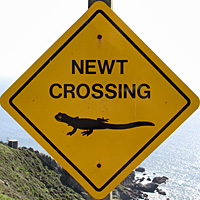California Newt - Taricha torosa
Page 2: Mating, Eggs, & Larvae
(= Coast Range Newt - Taricha torosa torosa)


| Mating Season Adult Activity | |||
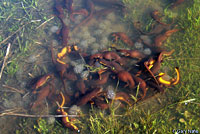 |
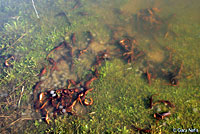 |
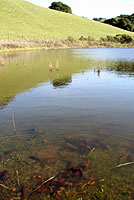 |
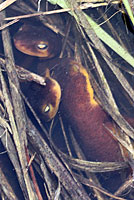 |
| A mass of breeding adults underwater in the breeding pond in early March, Contra Costa County | A mass of breeding adults underwater in the breeding pond in early March, Contra Costa County | ||
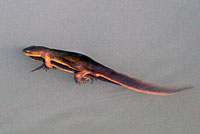 |
 |
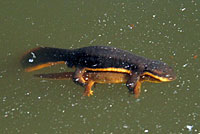 |
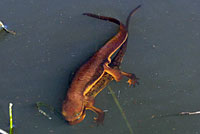 |
| Adults in amplexus, swimming in breeding pond, Contra Costa County | Adults in amplexus, swimming in breeding pond, Contra Costa County | Adults in amplexus, swimming in breeding pond, Contra Costa County | |
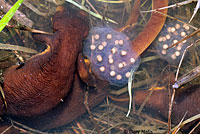 |
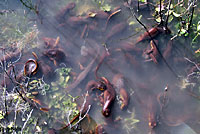 |
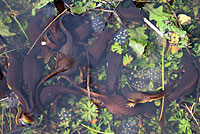 |
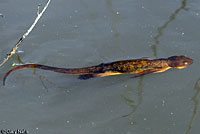 |
| Females laying their eggs underwater in the breeding pond in late February, Contra Costa County | Aquatic phase adult male in the breeding pond, Contra Costa County | ||
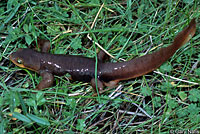 |
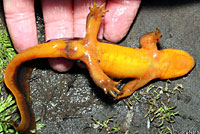 |
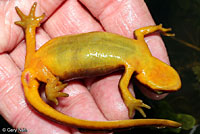 |
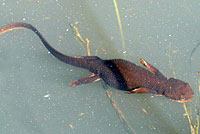 |
| Male, aquatic breeding phase, with smooth skin and flattened tail, Contra Costa County |
Adult Male in breeding season, Contra Costa County |
Adult Female in breeding season, Contra Costa County |
Breeding female swimming underwater, Contra Costa County |
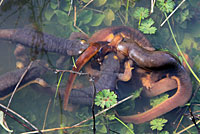 |
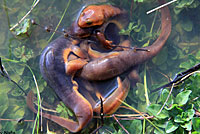 |
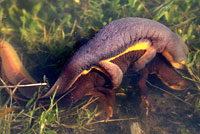 |
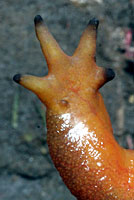 |
| Several males competing for a female that is somewhere in the middle of the mass. This was early in the breeding season when most newts in the pond were males. (Multiple amplexus, or mating balls, where numerous males surround one female can cause the death of the female by drowning.) |
Male (on top) female in amplexus | During the breeding season, adult males develop nuptial pads on the toes to improve their ability to hold onto females during amplexus. Compare to the toes of a breeding female without nuptial pads. | |
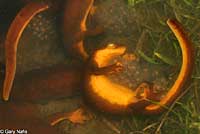 |
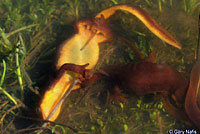 |
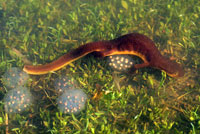 |
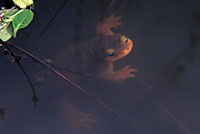 |
| Female laying egg mass underwater (while grasping onto another egg mass) | Female grasping onto underwater vegetation preparing to lay her eggs | Female laying her egg mass underwater | Aquatic phase adult male in breeding pond. |
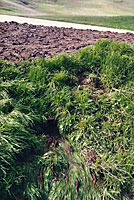 |
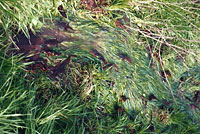 |
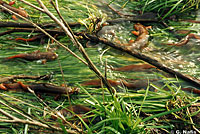 |
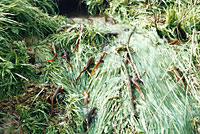 |
| These are some of hundreds of adult male newts that I watched one winter afternoon as they migrated up a small drainage to a breeding pond, slowly crawling against the current of water flowing from the pond through a small pipe. Their bodies have already undergone the change to their aquatic form, with smooth loose skin and broad flattened tails for swimming. The pond and pipe are visible in the picture on the left. To the right of that, you can see a logjam of newts at the opening to the pipe. I don't know why they kept struggling up the flow of water because they could have easily gone around the pipe and entered the pond in just a few minutes walk. It could be that they were washed out of the pond when the pond overflowed. | |||
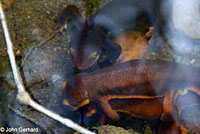 |
 |
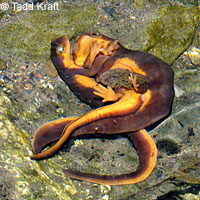 |
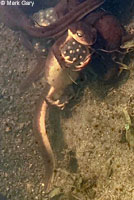 |
| Breeding newts, Santa Ana Mountains, Orange County © John Gerhard |
Mating ball, Santa Ana Mountains, Orange County © Ken Pitts | Two males struggling to amplex a female, Santa Ana Mountains, Orange County © Tadd Kraft |
Female newt underwater in a breeding pond in Alameda County holding her egg sac and apparently attaching it to a string of vegetation. © Mark Gary |
 |
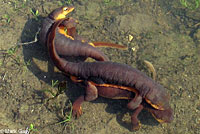 |
 |
|
| Male and female newts in amplexus in a breeding pond in Alameda County. The male is extruding his spermatophore. © Mark Gary | Two pairs of male and female newts in amplexus in an Alameda County breeding pond © Mark Gary | A male and female newt in amplexus swimming in an Alameda County breeding pond © Mark Gary | |
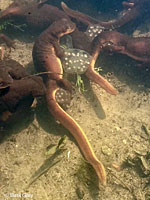 |
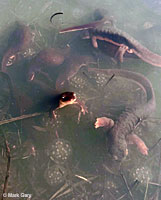 |
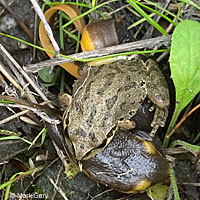 |
|
| A female newt laying her egg sac in a breeding pond in Alameda County © Mark Gary |
Male and female newts in a breeding pond in Alameda County © Mark Gary | Sometimes during the mating season a male frog mistakes another species for a female of his species and grabs onto it in amplexus as this Sierran Treefrog is doing with a California Newt in Contra Costa County. © Mark Gary | |
| Eggs | |||
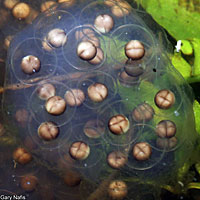 |
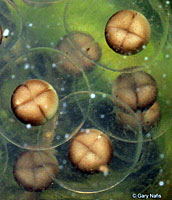 |
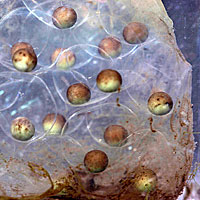 |
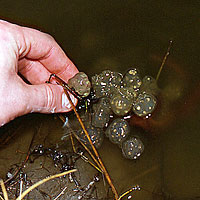 |
| Eggs, close-up | Eggs, close-up | Eggs, close-up | Cluster of eggs attached to underwater vegetation |
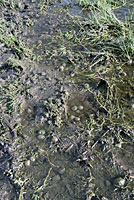 |
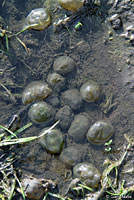 |
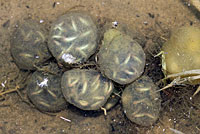 |
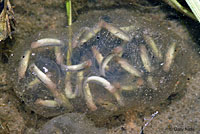 |
| Eggs at edge of breeding pond that is drying up |
Eggs at edge of breeding pond | Mature Eggs | Egg with mature larvae |
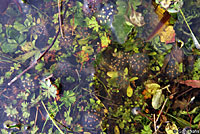 |
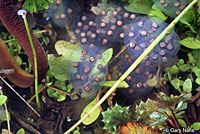 |
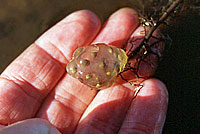 |
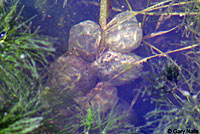 |
| Eggs at the shallow edge of a pond | Eggs at the shallow edge of a pond | Single egg cluster attached to underwater vegetation |
Eggs attached to a stem underwater. |
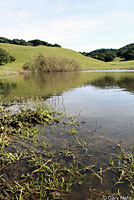 |
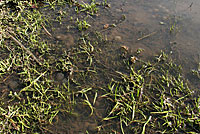 |
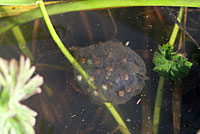 |
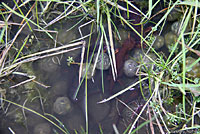 |
| Eggs attached to underwater vegetation at the edge of a breeding pond |
Eggs and Newts | ||
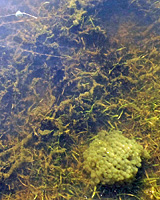 |
|||
| There are four types of amphibian eggs in this Alameda County pond in late February: On the top left near the surface is a Sierran Treefrog egg mass. To the right and slightly below that is a California Newt egg mass. Below these small egg masses are several recently-hatched California Toad egg strings (no longer eggs, really.) And the large egg mass in the bottom right corner of the picture is from a California Red-legged Frog. © Mark Gary |
|||
| Aquatic Larvae and Recently-metamorphosed Terrestrial Juveniles | |||
 |
 |
 |
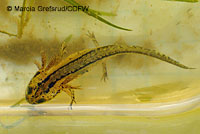 |
| Larva in June, Alameda County | Larva in situ in shallow pool, June, Alameda County | Larva, Alameda County © Marcia Grefsrud/CDFW |
|
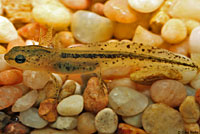 |
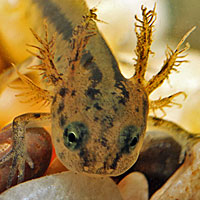 |
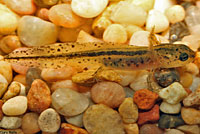 |
|
| Larvae in August, Alameda County |
|||
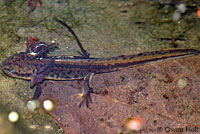 |
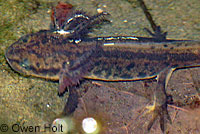 |
 |
|
| This 2.5 inch long (6.35 cm) larva was found in Santa Clara County on March 12th. It had spent the winter in the pond instead of transforming into a terrestrial newt the previous Summer or early Fall. It's color is darker than a typical T. torosa larva seen at the location that did not overwinter (which you can see to the right.) © Owen Holt | Typically-colored T. torosa larva, Santa Clara County. © Owen Holt | ||
The following series of pictures show a California newt larvae in various life stages, from a tiny aquatic larva, to a tiny, fully-metamorphosed terrestrial juvenile newt. |
|||
 |
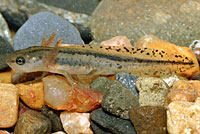 |
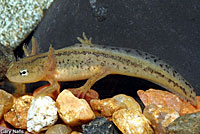 |
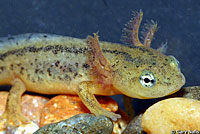 |
| Larva, underwater, June 29th. (This larva is most likely several months old.) | Larva, underwater, July 6th | ||
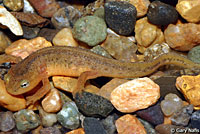 |
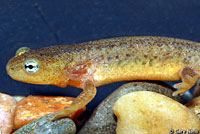 |
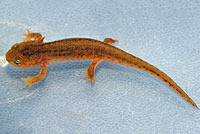 |
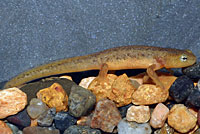 |
| Larva, underwater, August 4th, developing the warty skin and orange coloring typical of adult newts. Still living in water, but showing reduced gills, preceding the transformation to breathing air. |
|||
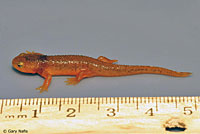 |
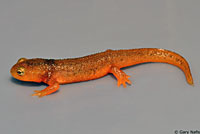 |
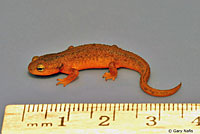 |
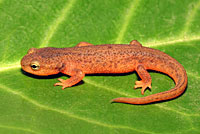 |
| August 7th, the same newt shown out of the water at about 5 cm (2 inches) total length. (The newt is now coming up for air, but still living in water. A tiny bit of the gills remain. The dark band around the neck shows where the skin is shedding. | August 9th, the newt has just emerged onto land, breathing air. The skin is rough and still retains some of the dark larval markings. | ||
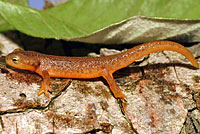 |
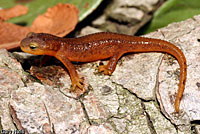 |
 |
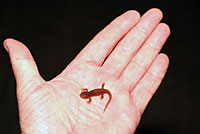 |
| August 13th | August 24th, the newt is now fully terrestrial with the appearance of an adult, but still very tiny. |
||
| Breeding Habitat | |||
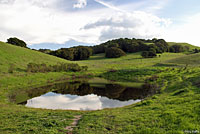 |
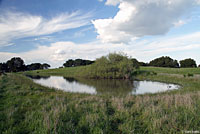 |
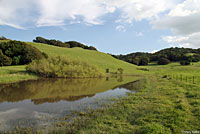 |
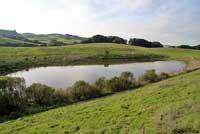 |
| Breeding ponds during breeding season, early March, Contra Costa County | Breeding pond during breeding season, late February, Contra Costa County | ||
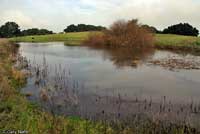 |
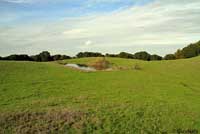 |
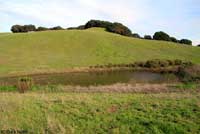 |
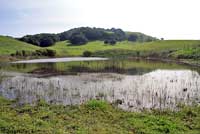 |
| Breeding pond during breeding season, late January, Contra Costa County | Breeding pond during breeding season, late February, Contra Costa County | Breeding pond during breeding season, late February, Contra Costa County | Breeding pond during breeding season, late February, Contra Costa County |
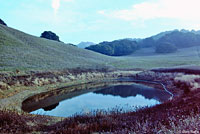 |
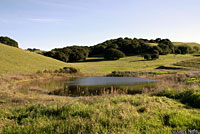 |
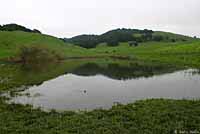 |
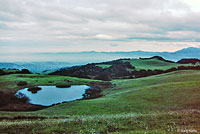 |
| Breeding pond during dry season, Contra Costa County |
Habitat, breeding pond in March, Contra Costa County |
Breeding pond during breeding season, February, Contra Costa County | Breeding pond in winter, Contra Costa County |
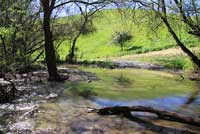 |
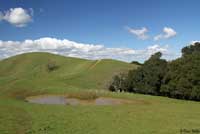 |
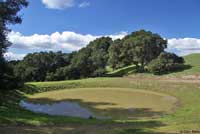 |
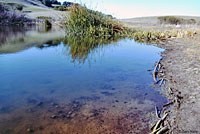 |
| Creek habitat where larvae were seen in summer, Alameda County |
Breeding pond, Contra Costa County | Breeding pond, Contra Costa County | Breeding pond, Contra Costa County |
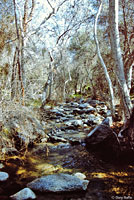 |
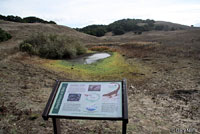 |
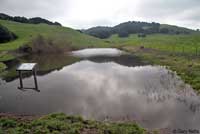 |
|
| Breeding creek, Kern County | Dry breeding pond in November, Contra Costa County |
Full breeding pond during breeding season, late January, Contra Costa County |
|
| Short Videos | |||
 |
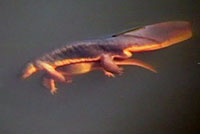 |
 |
 |
| A big ball of newts forms in the breeding pond when a male and female in amplexus are approached by several male newts who want to take the female. (Multiple amplexus, or mating balls, where numerous males surround one female can cause the death of the female by drowning.) |
Male and female newts in amplexus in the breeding pond. The males hold on tight and swim around the pond using their huge tails. One uses the toes on his hind feet to stroke a female, probably to make her receptive to take his spermatophore. | Views of a large mass of female newts in the breeding pond, as they go about laying and securing their eggs. | Female newts repeatedly attack and bite at newt egg sacs. Maybe they want to destroy the eggs for some reason or they're trying to eat them, or maybe there is another explanation. |
 |
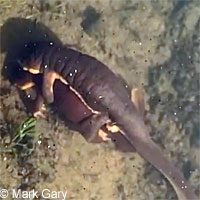 |
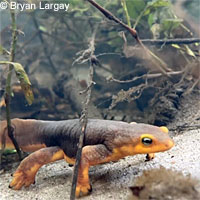 |
|
| At the beginning of the breeding season we see single males patrolling the edge of the pond waiting for females to arrive, and females crawling overland and entering the water. | This short video shows a male and a female California Newt in amplexus underwater in an Alameda County breeding pond. You can see the male stroking the female with his rear left leg to encourage her to take his spermatophore. © Mark Gary |
This is a YouTube video that takes you underwater into a creek in Santa Cruz County where California Newts are breeding, including a nice shot of females with their egg sacs on a submerged branch. © Bryan Largay | |
Return to the Top
© 2000 -

